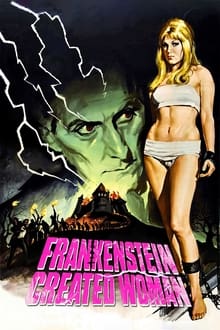
Gothic horror at its finest
Hammer Studios did seven Frankenstein films from the late 50s to early 70s:
Peter Cushing played Baron Frankenstein in every one of these except "The Horror of Frankenstein." The reason being "Horror" was a remake of the original story and they needed a much younger actor to play the role; they chose Ralph Bates (who superbly played the love-to-hate satanist in "Taste the Blood of Dracula," released the same year).
What got me interested in the series was "Frankenstein Must Be Destroyed," which is a creative and well-done piece of Gothic horror. Directed by Terence Fisher, "Frankenstein Created Woman" is similarly impressive. One thing that perked my interest in this film was Susan Denberg as the titular "woman"; she appeared in the 1966 Star Trek episode "Mudd's Women" as the blonde bombshell and was also a playmate-of-the-month that same year (not that I keep up on such things).
The story revolves around Baron Frankenstein (Cushing) resurrecting a young deformed, partially paralyzed woman (Denberg) in a very peculiar way and thus he "creates woman." Things go awry when his creation starts doing things she's not supposed to do (as usual).
With a title like "Frankenstein Created Woman" I wasn't expecting much. In fact, I was expecting unwanted goofiness but, no, this is a serious and moving piece of Gothic horror. Like all Frankenstein yarns faithful the spirit of Mary Shelley original tale, it's a tragedy at heart.
The story hooks the viewer right away with the dilemma of both Christina and Hans. Anyone who's ever been teased for one reason or another when they were young will no doubt relate to Christina. The only one who sees her true beauty and worth is the orphaned peasant, who is ostracized because his father was guillotined. By contrast the high-class mockers are cruel towards her. There's something about being poor in spirit that naturally creates true character and beauty; such is the case with both Christina and Hans. This is perhaps why a certain well known person said, "Blessed are the poor in spirit." Humility is beautiful; arrogance is repellent.
Another potent piece is the entire sequence culminating in someone being falsely accused. It effectively shows how easily someone can APPEAR to be guilty even though the charges are false. Add the pressure of governing officials to apprehend a culprit as fast as possible for political reasons and it’s a recipe for unjust indictment.
The film drives home the point that those who commit injustice and evil will reap what they sow sooner or later. The villains are good in a love-to-hate sense and the viewer can't help but hope they get their comeuppance.
Peter Cushing is excellent as Frankenstein. The story emphasizes his brilliance and skill, which so exceeds that of his contemporaries that he's accused of witchcraft. Some complain about the ending but actually it's a quite fitting way to end the storyline if you reflect on it.
Bottom Line: both "Frankenstein Created Woman" and "Frankenstein Must Be Destroyed" are excellent pieces of Gothic horror – intelligent, creative, potent, moving.
THE FILM RUNS 1 hour, 34 minutes, and was shot at Bray Studios, just west of London, and areas nearby (Surrey, Berkshire and Buckinghamshire). WRITER: Anthony Hinds.
GRADE: A-